 Blogs
Blogs
July 3, 2024 • 6 min read
Every GOAL programme is underpinned by at least one U.N Sustainable Development Goal. Using the SDGs as our roadmap, GOAL is implementing programmes in Africa, Latin America, and the Middle East to combat extreme poverty. We envision a world in which poverty no longer exists, where every person has access to the most basic necessities: nutritious food, quality healthcare, clean water, and enough money to survive.
What Are the SDGs?
In 2015, the United Nations adopted the 2030 Agenda for Sustainable Development. This framework outlines a long-term vision for a more sustainable, equitable world that is resilient and adaptable to future challenges. The agenda consists of 17 Sustainable Development Goals (SDGs).
The SDGs provide a comprehensive framework for addressing the interconnected nature of global issues. They integrate economic, social, and environmental initiatives that address a broad range of development challenges, offering a clear and unified roadmap for combatting poverty, protecting human rights, and fighting climate change. Each SDG is associated with specific targets, which detail the measurable, actionable steps that the international community must take to achieve the goals by 2030.
Is the World on Track?
Although significant progress has been made, a deadly mix of overlapping crises is threatening to undo our collective achievements. The impacts of climate change and conflict, coupled with the social and economic fallout of the Covid-19 pandemic, have all but erased four years of steady gains.
Humanitarian crises are increasing in number, magnitude, and complexity. In our globalised and interconnected world, shocks in one corner of the world can ripple across the globe, triggering or worsening crises elsewhere. Never has GOAL’s work been more relevant.
Goal 1: No Poverty
This goal aims to eradicate extreme poverty. If global trends continue, an estimated 575 million people worldwide will be living in extreme poverty by 2030 – meaning they’ll be living on less than $1.25 per day.
Every GOAL programme is underpinned by our overarching vision for a world in which poverty no longer exists. To build resilience in communities experiencing severe poverty, GOAL uses Cash & Voucher Assistance (CVA).
Individuals receive flexible cash transfers that can be used to purchase whatever their household needs most. CVA can generate sustainable pathways out of poverty when it’s invested in livelihoods and income-generating activities.
Haroon is a 70-year-old rickshaw driver from Sudan. When his rickshaw broke down, Haroon could not afford to pay for the repairs. He supported his wife and seven children using his monthly pension of 10,000 Sudanese pounds, or approximately $16. Haroon’s family was living on less than $0.53 per day.
GOAL selected Haroon for several rounds of cash assistance, which he used to repair his broken rickshaw. Now, Haroon earns an additional 75,000 Sudanese pounds, or $124, per month. With his new income, Haroon can purchase nutritious food for his children and pay for them to attend school.
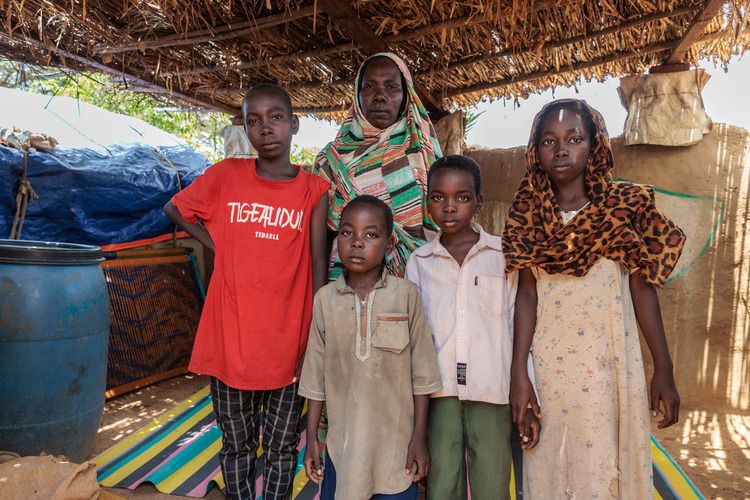
A family in Kutum, North Darfur, Sudan that received multiple rounds of multipurpose cash assistance to help them meet their daily household needs.
Goal 2: Zero Hunger
![]()
This goal aims to end world hunger and achieve global food security by promoting sustainable agricultural production and strong, functioning markets. Right now, one in every three people worldwide are experiencing moderate to severe food insecurity.
High food prices, limited employment opportunities, and reduced agricultural outputs due to climate change all play a role in food insecurity. To address these challenges, GOAL promotes climate-smart food production in resilient, equitable market systems – ensuring that every person can access and afford nutritious food.
In Honduras, this is achieved by investing in small-scale fisheries. Coastal, indigenous fishing communities in Honduras experience an array of challenges, including extreme poverty and high levels of food insecurity.
Infrastructure in these communities is often poor. Without reliable electricity and adequate refrigeration, most fish caught by small-scale fisheries spoils during processing and cannot be sold. Access to formal financial services is limited, meaning these fisheries can not make the investments that would be necessary to increase their outputs.
GOAL empowers local fishers with business and financial training, in addition to improved access to much-needed infrastructure and technology. This, coupled with knowledge of sustainable, climate-friendly fishing practices, strengthens the capacity of small-scale fisheries to catch, process, and sell fish.
Under our Resilience of the Blue Economy Programme, these small-scale fisheries are transformed into resilient, sustainable food systems that can provide food security and economic opportunities to the local community for years to come.
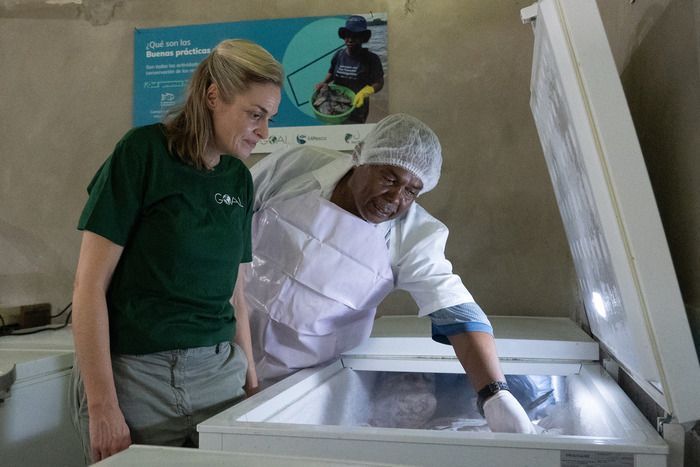
Courtenay Pollard, GOAL Trust & Foundations Manager, visiting a small-scale fishery in Honduras that received technical and vocational support from GOAL.
Goal 3: Good Health & Well-Being
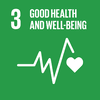
This goal aims to promote well-being and healthy lives for every person. Notable progress has been made, but there is still more to be done. For example, one woman dies every two minutes from preventable causes related to pregnancy and childbirth.
GOAL promotes positive health outcomes by supporting resilient public and community health systems that respond to the needs of the communities they serve, while also addressing the underlying causes of poor health.
Sierra Leone has one of the highest adolescent pregnancy rates in the world. A staggering 46.8% of all adolescent deaths occur due to pregnancy and childbirth complications. GOAL is working with local communities and healthcare professionals to break through cultural and systemic barriers and provide high-quality sexual and reproductive health services to teenagers.
In the districts of Sierra Leone where GOAL implemented Adolescent Sexual and Reproductive Health (ASRH) programming, the percentage of female adolescents aged 15 to 19 who used a modern method of contraception rose from 38% in 2018 to 58% in 2022. For women aged 20 to 24, the figure rose from 26% to 71%.
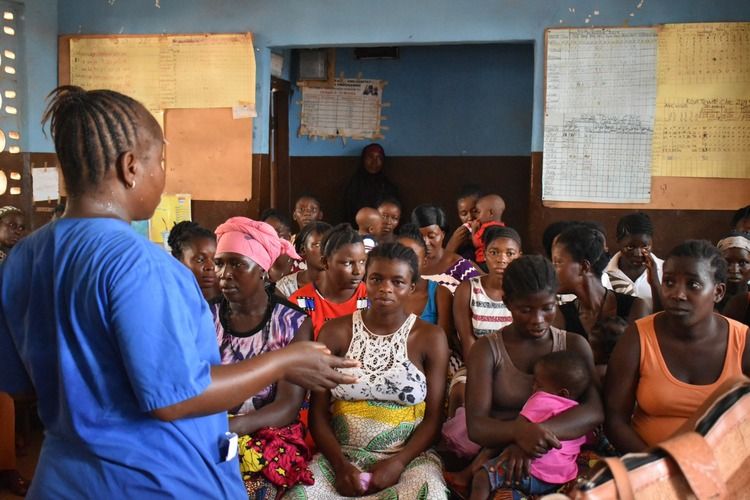
A GOAL-supported peer mentor delivering a workshop on sexual and reproductive health best practices in Kenema, Sierra Leone.
Goal 6: Clean Water & Sanitation
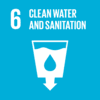
This goal aims to ensure the availability and sustainable management of water and sanitation for all. Access to clean water underpins all elements of human well-being. It’s an integral part of good health, food security, and economic development. However, nearly 2 billion people globally do not have access to safe, clean water.
In Northwest Syria, public water infrastructure has been continually damaged by over a decade of conflict. The catastrophic earthquake in 2023 wreaked further havoc on the water supply. Of the 2 million people in Northwest Syria who have been displaced by conflict or the earthquake, only 27% are connected to a formal water network.
GOAL teams have been repairing damaged water systems in Idleb and Aleppo since 2014. Right now, GOAL is working to supply clean tap water to approximately 800,000 people in the region, including Hussein.
Hussein’s family, including his nine children, have been living in a displacement camp in Northern Aleppo ever since the earthquake destroyed their home last February. Previously, there was no running water in the camp. Hussein’s children were forced to drink contaminated rainwater and began to suffer from bouts of diarrhoea and vomiting as a result.
GOAL teams recently completed the construction of a water tower in the camp, giving families like Hussein’s access to drinkable water from a safe, reliable source.
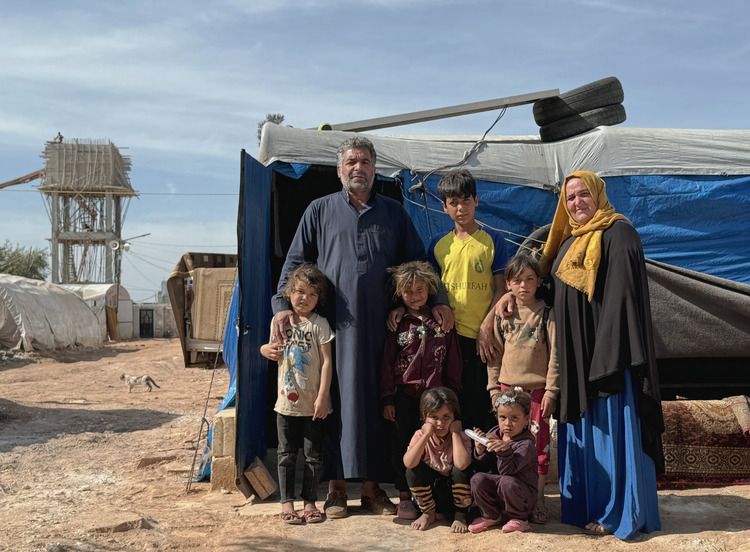
Hussein and his family in front of their tent in Al-Wadah, Northern Aleppo, Syria, with the new water tower visible.
